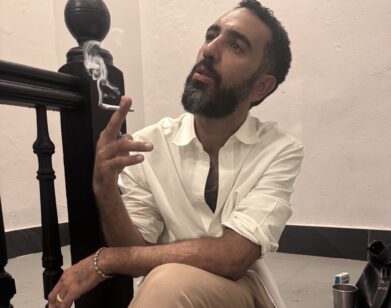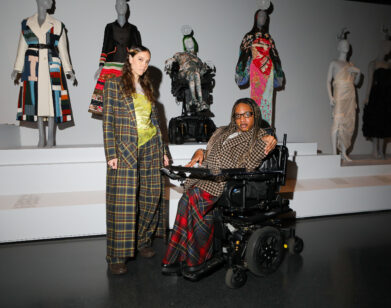Anohni Sets Out, Once Again, on a New Artistic Odyssey

There is always more to Anohni than meets the eye. Perhaps best known for her Academy-Award-nominated, Mercury-Prize-winning music, Anohni’s visual art practice is just as mercurial, unguarded, and ever restless. She’s exhibited her multimedia works, which span collage, painting, video and more, from spaces as diffuse as the Hammer Museum in Los Angeles to Denmark, where she was artist-in-residence at the 2017 European Capital of Culture. Anohni’s latest conceptual odyssey, Love, comes to the Kitchen in New York City this month, and it’s as ambitious as the subject implies. In the exhibition, photography, printmaking, American vaudeville, and queer storytelling live alongside Living Theater-esque abstraction, painting and environmental activism. Running concurrently with the show are a series of bawdy theatrical performances with a cast featuring Charles Atlas, Laurie Anderson, Eliza Douglas and Connie Fleming. Billed as “The Johnsons Present She Who Saw Beautiful Things,” the showcase marks something of a full-circle moment for the artist — Anohni first performed under the name Antony and the Johnsons, at the Kitchen in 1997. Later this May, Anohni will also be an honoree at the Kitchen’s annual gala, alongside the artist Robert Gober. Ahead of these much-anticipated performances, Interview spoke with Anohni about her New York City nightclub roots, the different experiences of navigating the music industry and the art world, and her late friend, Dr. Julia Yasuda.
———
ALEX HAWGOOD: It’s been 23 years since you last performed at the Kitchen. That’s quite a gap.
ANOHNI: Well, in the ‘90s I tended to perform mostly in nightclubs — places like the Pyramid Club in the East Village and later on at this club called Mother, where I used to put on experimental theater pieces with my friends. I had a group called Black Lips from 1992 to 1995. And then I started an ensemble called The Johnsons. We were sort of a nightclub performance group —myself, Johanna Constantine and Dr. Julia Yasuda. There were lots of other guests — really wonderful New York City trans and punk women, like Amanda Lepore and Kembra Pfahler from The Voluptuous Horror Of Karen Black. All sorts of other characters, including Kenny Kenny. Do you know him?
HAWGOOD: The legendary nightlife doorman?
ANOHNI: Yes, I used to work at Limelight in the mid ‘90s and I met Kenny there. I think I’m actually the only person he ever performed for. When I first moved to New York, I used to see him as an M.C. at the Palladium nightclub. There was a party there called Panty Girdles in the ‘90s that was just a really great night. There is this really beautiful photo of him by Francesco Scavullo in a blonde wig and a cigarette. It is so iconic. I always just adored Kenny.
HAWGOOD: People don’t always know you cut your teeth in after-dark experimental theater before becoming an international songbird.
ANOHNI: I was inspired by Jack Smith, the Angels of Light theater commune and just the present moment at that time — the mid-90s leading up to the millennium. I named the Johnsons after [legendary gay and transgender advocate] Marsha Johnson. The Johnsons and Black Lips were both very surrealist and theatrical. Black Lips was a collective that ended up becoming a group of about 15 people. For the first few months, I wrote all the plays and then everyone else pitched in. Soon it became this kind of monster where each week every member of the group would write a play. We would perform at 1AM on Monday morning — or Monday night — at the Pyramid.
HAWGOOD: The Pyramid is still there, thankfully. What was it like back then?
ANOHNI: In those days, the Pyramid had already sort of had its heyday in terms of being a very popular gay club. It was almost an abandoned nightclub at that point. There were a couple of nights that were still hopping, but the big difference was in those days there was a really big backstage area. You used to have to hike up and down this ladder that would bring you to this dressing room. It was a wonderful, wonderful theater. A lot of great things happened there between 1980 and 1995 — so many wonderful performers and artists crossed that stage. I’m sure if kids wanted to they could probably go get a night at the Pyramid still if they wanted to. [Laughs]
HAWGOOD: The children definitely still go there on occasion.
ANOHNI: I’m sure.
HAWGOOD: Your current project with The Kitchen seems to recall this earlier madcap approach to theater and art making. Alongside the live performances, there are new works in painting, sculpture and archival video, and a limited-edition book photographs featuring your close friend (and Antony and the Johnsons’ member) Dr. Julia Yasuda, who passed away last year. Why did you decide to work in this multi-format way?
ANOHNI: It sounds quite serious, but it’s full of poppycock, violence, beautiful songs and very still moments. It’s not particularly linear or particularly narrative. The structure is like an odyssey, almost modular. Certainly one of the reasons for why I made these works is that Julia was gone. She was magical for me. She was the sacred heart of my work in a weird way. She had Klinefelter’s syndrome, which means she had XXY chromosomes. She had an intersex condition. She was older than me — born during the second World War in Japanese-occupied China. She moved to New York in the late ‘80s after her wife, who was a photographer, had died. Julia was her wife’s muse, a divine hermaphrodite in a way, a beautiful androgyne and a kind of creature. She was very precious to me. Beyond that, I have also been increasingly focusing on my visual work instead of music. I retreated back to some of my earlier artistic practices in order to have some privacy and some space separate from this other thing that had happened, which was wonderful and I am so grateful for but sometimes kind of alienating.
HAWGOOD: Most artists tell me the music industry chews you up.
ANOHNI: It is definitely a rollercoaster, you know? I was pretty set on staying in experimental theater, but I switched tracks to music at the end of the 1990s because there was so little interest and support for that kind of work in those days. Starting in 1998, I began focusing on music pretty much full time. I performed with symphonies all over the world in the most beautiful opera houses. I did a lot of really wonderful things, but with very, very different audiences than the ones I had been used to performing in front of in New York City for the 15 years prior. I didn’t start to have an international profile as as a singer until I was in my 30s, but I had been performing in New York since I was in my 20s. I had this whole other life. The work I was doing came from this specific subculture and environment born out of NYC. When I started doing music for people around the world, there was a slight disconnect between the people enjoying the music and the sounds because they didn’t know where I really came from and what was really at the root of me.
HAWGOOD: Does this new exhibition, book and performances better reflect who you are?
ANOHNI: Well, a wider array of practices allow me to focus on how to engage as an adult artist with visual work, music, elements of theatricality, dance and observations of space. The most whole viewfinder — most holistic way — to engage with creativity is to make live work on the stage with my community. It engages all my muscles as an artist.
The art world, too, has changed a lot and is beginning to embrace that multimedia artists actually exist and have legitimate points of view. When I was doing this kind of work in the ‘90s, the experimental theater world couldn’t really express — wasn’t ready yet — to really attend to the kind of work and the kind of people I was working with as viable subjects and performers.
HAWGOOD: Do you mean queer and trans folks?
ANOHNI: It was a very different, more transphobic and homophobic environment, let alone for an artist who was really embracing this kind of oral history that was still hard to grasp for someone of my generation in the ‘90s.
HAWGOOD: How does that compare to the current social media-era we find ourselves in today?
ANOHNI: Now everything has changed with technology. You can be in Papua, New Guinea and learn about Leigh Bowery on Youtube. Whereas before the internet all of that information was very hard to access. You had to either be there or know someone who was there.
HAWGOOD: It feels increasingly like our iPhones are double-edged swords.
ANOHNI: The internet really changed the way culture is disseminated and ultimately produced. The Johnsons was an analog experience — it was something you would get a flyer for at a nightclub somewhere. It probably wasn’t even listed in the Village Voice. You would hear from a friend and then you would go to the nightclub and sit in this little chair and see this incredible thing unfolding. No one had cell phones or was taking pictures. It was something absorbed through your eyes. There was this feeling with that kind of work that felt much more rare. It was beautiful. It was something that we treasured. We were working with marginalized figures in the community, so there was only a small contingent of people who understood why this was so beautiful. It was a kind of insider job.






